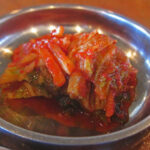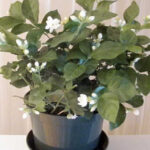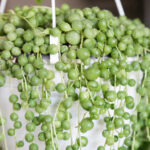Are you looking for something just a bit different by way of ground cover? Maybe something taller than wooly thyme or mazus reptans, but with a similar pop of color? Cotoneaster horizontalis is an excellent choice!
Brilliant red berries decorate this deciduous shrub once it has stopped flowering. Small, rounded dark green leaves give an almost lacy look to its branches. And in the fall, the leaves turn brilliant shades of orange and red, just in time for your Halloween display. All of this is why it has received the Royal Horticultural Society Award of Garden Merit.
It isn’t anywhere near as low-lying as most of the popular ground cover plants. This one isn’t a good choice for a lawn replacement, as an example, especially because it’s one of 5 Cotoneaster species that are invasive. But if you’ve got a bare hillside that needs erosion control, or border space that needs something, this works.
Let’s talk about rock cotoneaster and how to maintain and care for it!
Quick Care Guide
 Pink cotoneaster flowers are understated, but pretty before berries form. Source: wallygrom
Pink cotoneaster flowers are understated, but pretty before berries form. Source: wallygrom| Scientific Name | Cotoneaster horizontalis |
| Common Name(s) | Rock cotoneaster, rockspray cotoneaster |
| Family | Rosaceae |
| Height & Spread | 2-3′ tall, up to 8′ spread |
| Sun | Full to partial sun |
| Soil | Loamy, well-drained soils; can tolerate poor soils |
| Water | Average – keep soil moist but not wet |
| Pests & Diseases | Cotoneaster webworm, lace bugs, fire blight |
All About Rock Cotoneaster
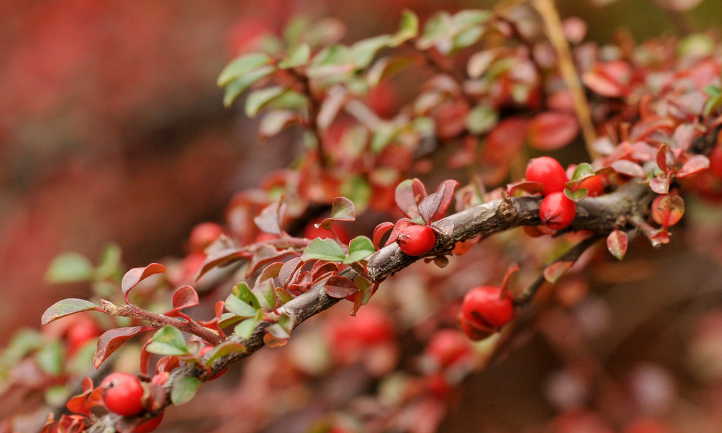 When ripe, cotoneaster berries are a bright scarlet color. Source: HorsePunchKid
When ripe, cotoneaster berries are a bright scarlet color. Source: HorsePunchKidCotoneaster horizontalis is a semi-evergreen deciduous shrub in the family, rosaceae genus, Cotoneaster. It spreads readily — in fact, it’s classed as an invasive species. It grows with stiff and evenly-branched sprays of foliage. These sprays develop a distinctive herringbone pattern which is quite appealing.
The tiny, rounded leaves are quite pretty. Glossy and green through most of the year, they turn vibrant shades of red and orange in fall. The plant loses all greenery for the winter. Denuded branches maintain their stiff fan-shape.
In the spring months, pink-tinged flowers appear. These are rarely clustered, instead appearing in ones or twos evenly across branches. As the flowers fade, the fruit begins to appear, and a myriad of small berries form. These begin as yellowish fruit, but will turn a brilliant scarlet color.
The berries of Cotoneaster horizontalis are consumed by birds and seeds are then spread far and wide, out competing other plants. The plant has a natural layering effect which is beautiful. The stiff, semi-hardwood branches fan out over each other. This provides a visual effect of filling in the gaps between the branches. But it does make it a bit difficult to remove fallen leaves and berries under the branches in the late fall.
Native to China, the tiny leaves and brilliant berries have made this a garden staple in many other areas. It’s especially popular in cooler climates, preferring USDA zones 5-7. Coastal climates and mild regions provide a perfect home. Unfortunately, it has been the cause of some ire as its invasive nature means it will overtake nearby beds and native plants. Therefore, a list of alternative plants like cotoneaster may be worth consulting.
Cotoneaster horizontalis is larger than most ground cover plants, growing two to three feet tall and up to eight feet wide. As a border plant or hillside foliage, it does phenomenally well — too well, in fact. It’s an such an effective erosion control plant, it pushes out native species. However, there are ways to control its spread.
Despite the invasvie nature of this deciduous shrub, it has received the Royal Horticultural Society Award of Garden Merit, and the Jepson Flora Project has identified the small sliver of the western US where it’s naturalized. If you live in the Northern Coast of the California, grow away!
Caring For Your Cotoneaster Horizontalis
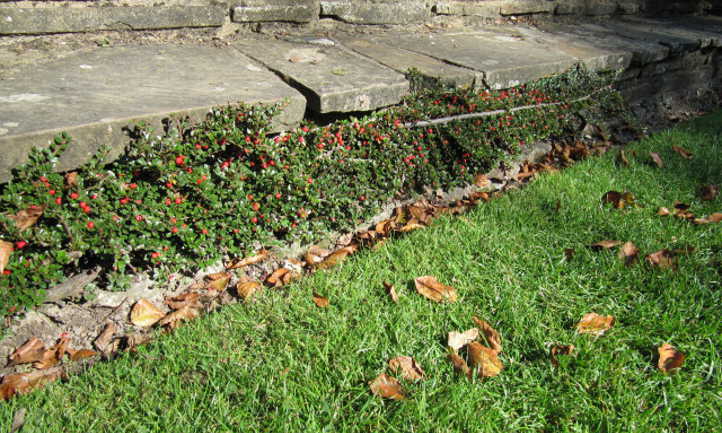 As a border plant, cotoneaster horizontalis makes a beautiful display. Source: wallygrom
As a border plant, cotoneaster horizontalis makes a beautiful display. Source: wallygromThe tumbling display of the Cotoneaster horizontalis plant works well in rock gardens, long beds, and on hills. It can be grown as a container plant, although it prefers long planters to narrow pots. Let’s talk about caring for this plant and ensuring to your best ability it doesn’t escape and cause ecological problems.
Light & Temperature
As I said above, zones 5-7 are ideal in the US. It’s especially popular now in coastal gardens due to their milder temperatures. This plant can struggle in hotter climates, and isn’t the best choice for zones 8 and above.
It tolerates full sun to partial shade, but doesn’t flower well in full shade conditions. Therefore, keeping the plant in full shade and out of full sun may prevent it from becoming invasive. There you can enjoy the stunning fall foliage of this semi-evergreen shrub without any of the fallout.
Water & Humidity
Once established, rock cotoneaster can handle drought like a champ in partial shade. Full-sun plantings need a bit more moisture, as do younger plantings while they grow.
Consistent soil moisture is best for Cotoneaster horizontalis. If you can provide a small amount of water on a consistent basis, it’s better in the long-term for these plants. Consider soaker or drip irrigation underneath the foliage for ease of watering.
Humidity-wise, this plant is fine as long as there’s consistent airflow. They’re not generally susceptible to many of the moisture-related diseases. Coastal conditions often provide enough air moisture that watering frequency is greatly reduced.
Like most plants that do well in coastal climates, this one tolerates higher salt content. It is resistant to sodium-based ice melt products and road deicers, too. Try to minimize the deicer’s spread to the soil as much as possible. Moist, salty sea spray is fine!
Soil
In a perfect world, your cotoneaster plants would have loamy, well-draining soil. It would hold just enough moisture to sustain the plant, but water wouldn’t pool around the roots.
Poor soil is tolerated by these plants, but only if it drains off excess moisture. As deciduous plants, they provide a lot of organic material when they drop leaves in the fall. Over time, they can actually improve their own soil a bit just by dropping leaves. But if possible, new plantings should be in soil which has a lot of decomposed plant matter to start with.
Different pH levels rarely have an effect on this plant. It will tolerate a wide range of conditions from lightly acidic to lightly alkaline. If you aim for a neutral range, it’s easiest to maintain.
Fertilizer for Cotoneaster Horizontalis
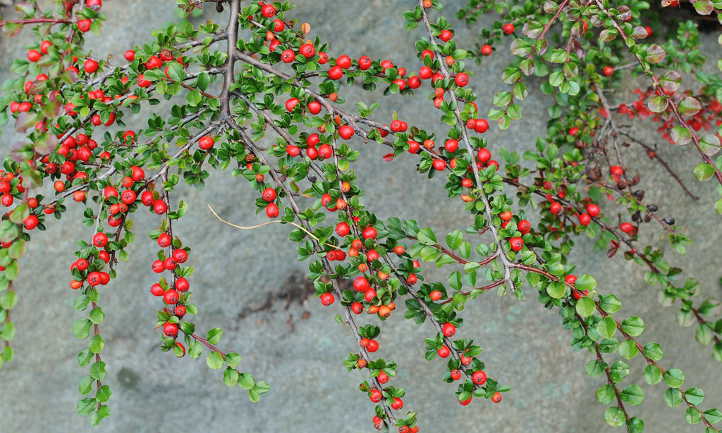 The branches of rock cotoneaster have a fishbone shape to them. Source: HorsePunchKid
The branches of rock cotoneaster have a fishbone shape to them. Source: HorsePunchKidWhile you may not want to fertilize and promote growth of an invasive species, fertilizing is best done when the plant is beginning to develop new glossy dark green leaves in spring. It needs a slightly higher nitrogen content for its greenery and for spreading. A 10-8-8 slow release is fine for spurring new growth.
I prefer slow-release granular fertilizers for this plant, but you can use liquid options as well. With slow-release fertilizers, apply once in early spring. Liquid formulations can be applied once per season, but diluted to lower levels to avoid over-fertilization.
Cotoneaster Horizontalis Propagation
Propagation is best done from softwood cuttings in the early summer. Select a healthy stem with plenty of young leaves, preferably one that’s vigorous. Remove lower leaves, and dip in water and a powdered rooting hormone. Be sure to cover some young leaf buds with hormone, as the roots will develop from the lower buds.
However, because this plant, and five other members of the genus Cotoneaster are invasive, propagation isn’t necessary. The plant will spread easily.
Pruning Your Rock Cotoneaster
Most pruning should be to prevent overflowing boundaries, and to remove flowers before its bright red berries form, which spread invasively. Again, alternative plants may be better suited to your property. Removal of dead or diseased wood is also an option.
If a disease has affected your plant, remove at least 8-12″ past the blighted part of the stem to be sure you get it all. Sometimes, this may mean cutting back to the main trunk of the plant.
Use sterilized, sharp pruning shears. Between cuts, set your shears in a mixture of 1 part bleach to 9 parts water for at least 10 seconds. This ensures that every cut is sterile and you aren’t spreading disease.
Troubleshooting Cotoneaster Horizontalis
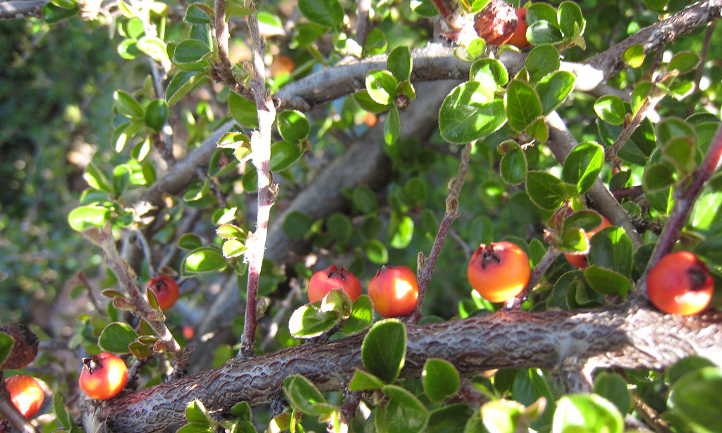 As berries form, they begin yellow and gradually turn red with time. Source: nautical2k
As berries form, they begin yellow and gradually turn red with time. Source: nautical2kAs a general rule, very little will be a problem for your cotoneasters. While there are some pests and diseases that will impact them, they’re limited. We’ll go over those specific problems now, and how to handle them should they arise!
Growing Problems
Over or under fertilizing can create chlorosis, or yellowed leaves. It can also promote the invasive nature of the plant. If your plant’s leaves begin to yellow and it’s spring or summer, consider when you last fertilized. If the answer is “never”, it’s a good idea to fertilize with a balanced fertilizer.
You’ll most likely have issues with Cotoneaster horizontalis getting out of hand. To prevent this, prune away flowers before they form berries. This is one way to control already planted members of the genus Cotoneaster.
Watering too much or too little is another problem. Overwatering can create conditions which lead to fungal root rots. Underwatering, while less of a problem, can lead to leaf-drop or plant weakness. Maintaining consistent, but not heavy soil moisture is best for these plants.
Pests
The cotoneaster webworm is a caterpillar. It feeds on plant leaves and can cause major defoliation of branches. The worse the damage, the harder the plant finds it to properly make chlorophyll.
Treatment of this caterpillar should be done with a bacillus thurigiensis spray. This bacterial spray will eliminate most forms of caterpillar. Only spray where necessary to kill off this webworm.
Lace bugs are another form of pest common in the western US. Not to be confused with the beneficial lacewings, lace bug nymphs will suck moisture from the leaves. This leaves a stippled, dotted surface and damages the leaves themselves. They also leave sticky, black excrement on the leaf surfaces.
Insecticidal soaps and neem oil both work well to eliminate these pests. Adding lacewings to your garden provides a natural predator for the lace bug.
Spider mites may come to call, especially during drier times. Regularly spraying down the foliage of your cotoneaster plants will reduce their numbers. A neem-based spray can keep them at bay.
Armored scale insects may develop from the late winter into the early spring. These typically attach to the branches of your plant itself. Use a horticultural dormant oil or neem oil in the fall and winter to prevent them from attaching.
Some forms of aphid, particularly the apple aphid, may attack your plant. While they do limited damage, they can spread disease easily. Neem oil will also handle these pests.
Diseases
 In autumn, the leaves turn vibrantly red-orange. Source: OliBac
In autumn, the leaves turn vibrantly red-orange. Source: OliBacCotoneaster horizontalis is especially vulnerable to the Cotoneaster fire blight. Caused by Erwinia amylovora, this causes many problems. A sticky ooze can develop on the twigs and limbs. Blossom blight can cause the flowers to go necrotic. Fresh shoots can develop a crooked shape, like a shepherd’s crook.
This same blight can cause cankers on the stems. These appear as sunken areas on the stems or branches. There may be cracking around the canker’s surface, especially as it dries. Active cankers will have an amber or brown ooze in or around the canker.
With sterile tools, and sterilizing between cuts, removing infected branches is essential. Certain horticultural copper fungicides may be used in rare occasions. However, none of these formulations are available on the mass market. Incorrect use can cause serious harm to your plant. It’s easier to remove the damaged portions or to get professional help.
Entomosporium leaf spot is another common Rosaceae family problem. This fungal-based leaf spot disease causes reddish spotting on the leaves. Sometimes the spots may be surrounded with a purplish halo. In time, the underside of the spot will develop spores and the disease will spread.
With this leaf spot, copper fungicides are again risky. There are some products made with essential plant oils and malic acid which may help. Removal of diseased branches is better, but be sure to also remove any fallen leaves. The spores of the disease can linger on leaf debris.
Frequently Asked Questions
Q: Can cotoneaster be evergreen?
A: In very limited conditions, yes. The upper part of zone 7 might be able to maintain year-round foliage in sheltered conditions, but only in frost-free zones. Some California coastal areas might work. But you’d miss out on that glorious fall color!
Q: Are cotoneaster berries edible?
A: Cotoneaster species can be poisonous to humans and pets, both the foliage and the berries. The California Poison Control Center considers them to be level 4 toxic plants. Many species of birds love them, though.
Q: Where is the best place to plant a cotoneaster?
A: Plant your cotoneaster in well-draining soil in an area that gets full sun to partial shade.
Q: How fast growing is cotoneaster?
A: At first cotoneaster is slow, and after a few years of growth it will put on a foot to 1.5 feet of growth per year.
Q: Can cotoneaster be cut back hard?
A: Instead of cutting it back hard, lightly prune it throughout its growth, removing dead or damaged foliage as needed. Always prune it back to prevent it from taking over an area.
Q: Are Cotoneaster roots invasive?
A: Yes. Cotoneaster horizontalis is among 5 other Cotoneaster species that is highly invasive in many parts of North America, and other parts of the world too.
Q: Should I remove Cotoneaster?
A: If you don’t want it to spread and outcompete other plants, yes. Remove it.
Q: What is the lifespan of a Cotoneaster?
A: Most Cotoneaster horizontalis plants live for 11 to 20 years.




